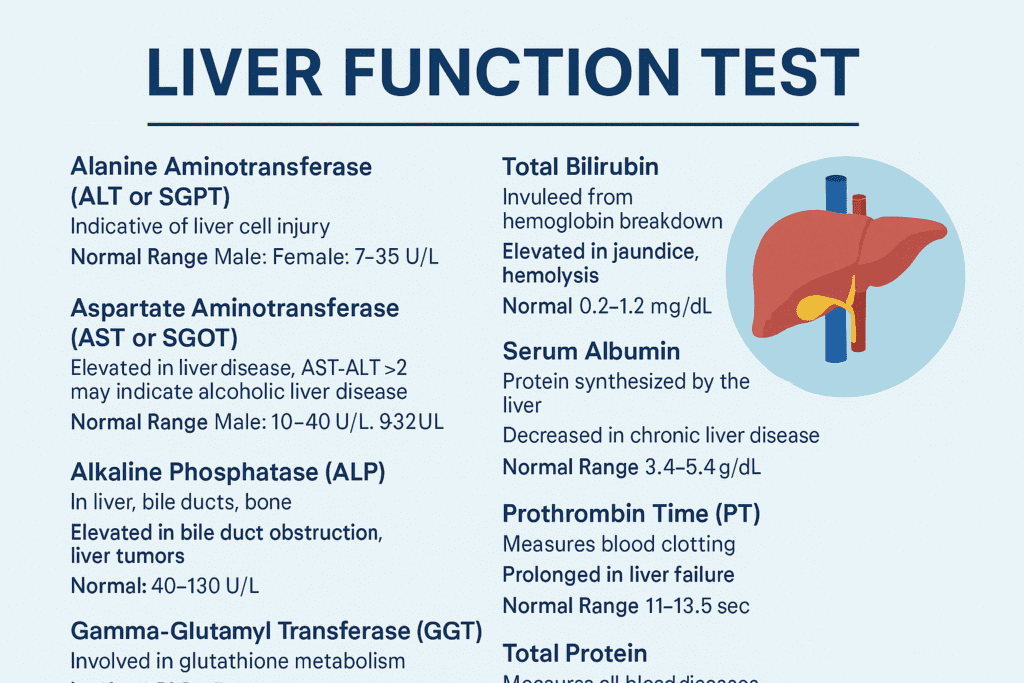Liver Function Test (LFT): A Comprehensive Guide
The liver is a vital organ responsible for several physiological functions including metabolism, detoxification, protein synthesis, and storage of essential nutrients. To assess the health and functionality of the liver, a panel of blood tests known as Liver Function Tests (LFTs) is used.

LFTs help in diagnosing liver diseases, monitoring the progression of liver conditions, and evaluating the effects of medications or toxins on liver health. These tests measure enzymes, proteins, and substances produced or excreted by the liver.
Major Components of Liver Function Tests
LFTs typically include the following sub-tests:
1. Alanine Aminotransferase (ALT or SGPT)
- Function: ALT is an enzyme found primarily in the liver. It helps convert alanine, an amino acid, into energy. When liver cells are damaged, ALT leaks into the bloodstream.
- Clinical Significance:
- Elevated in acute hepatitis (viral, drug-induced)
- Indicative of liver cell injury
- Normal Range:
- Male: 10–40 U/L
- Female: 7–35 U/L
2. Aspartate Aminotransferase (AST or SGOT)
- Function: AST is found in liver, heart, muscles, and kidneys. It plays a role in amino acid metabolism.
- Clinical Significance:
- Elevated in liver disease, myocardial infarction, muscle disorders
- AST:ALT ratio >2 may suggest alcoholic liver disease
- Normal Range:
- Male: 10–40 U/L
- Female: 9–32 U/L
3. Alkaline Phosphatase (ALP)
- Function: ALP is an enzyme found in liver, bile ducts, and bone. It helps break down proteins.
- Clinical Significance:
- Elevated in bile duct obstruction, liver tumors, bone diseases
- Very high levels in cholestasis or bone growth (in children)
- Normal Range:
- Adults: 40–130 U/L
4. Gamma-Glutamyl Transferase (GGT)
- Function: GGT is involved in the metabolism of glutathione and drug detoxification.
- Clinical Significance:
- Sensitive marker for bile duct injury and alcohol use
- Often elevated with ALP in cholestatic liver diseases
- Normal Range:
- Male: 10–71 U/L
- Female: 6–42 U/L
5. Total Bilirubin
- Function: Bilirubin is a yellow pigment formed from the breakdown of hemoglobin.
- Clinical Significance:
- Elevated in jaundice, hemolysis, hepatocellular or obstructive jaundice
- Helps differentiate between direct (conjugated) and indirect (unconjugated) hyperbilirubinemia
- Normal Range:
- Total: 0.2–1.2 mg/dL
- Direct (conjugated): 0.1–0.3 mg/dL
- Indirect (unconjugated): 0.2–0.8 mg/dL
6. Serum Albumin
- Function: Albumin is a protein synthesized by the liver. It maintains oncotic pressure and transports substances.
- Clinical Significance:
- Decreased in chronic liver disease, nephrotic syndrome, malnutrition
- Marker of liver’s synthetic function
- Normal Range:
- 3.4–5.4 g/dL
7. Total Protein
- Function: Measures all proteins in the blood, primarily albumin and globulin.
- Clinical Significance:
- Altered in liver diseases, kidney diseases, and infections
- Helps in detecting chronic inflammation and nutritional status
- Normal Range:
- 6.0–8.3 g/dL
8. Prothrombin Time (PT) (sometimes included in extended LFT panels)
- Function: PT measures the time taken for blood to clot. Liver produces clotting factors necessary for coagulation.
- Clinical Significance:
- Prolonged PT in liver failure
- Important pre-operative assessment in patients with suspected liver dysfunction
- Normal Range:
- 11–13.5 seconds (may vary slightly by lab)
Interpretation of Liver Function Test Results
| Condition | Common LFT Findings |
|---|---|
| Acute Hepatitis | Markedly elevated ALT and AST (ALT > AST), mild ALP increase |
| Chronic Liver Disease | Mild ALT/AST elevation, decreased albumin, prolonged PT |
| Alcoholic Hepatitis | AST:ALT >2, elevated GGT |
| Obstructive Jaundice | Elevated ALP and GGT, elevated direct bilirubin |
| Hemolytic Jaundice | Elevated indirect bilirubin, normal liver enzymes |
| Cirrhosis | Low albumin, prolonged PT, mildly elevated enzymes |
Clinical Applications of LFT
- Diagnosis: Identifies liver diseases like hepatitis, fatty liver, cirrhosis, and cholestasis.
- Monitoring: Used to follow disease progression or resolution, especially in chronic liver diseases and drug-induced liver injury.
- Pre-surgical Evaluation: Essential for patients undergoing surgery or on long-term medications metabolized by the liver.
- Screening: Used in routine health checkups to catch early liver dysfunction in asymptomatic individuals.
Factors Affecting LFT Values
- Medications: Statins, anti-TB drugs, paracetamol, antiepileptics
- Alcohol: Chronic use can elevate AST, GGT
- Pregnancy: ALP can be elevated due to placental isoenzymes
- Age and Gender: Reference ranges differ slightly
Conclusion
Liver Function Tests provide essential information about the health and performance of the liver. While no single test gives a complete picture, the combined interpretation of all LFT components helps healthcare professionals diagnose, monitor, and manage a wide range of hepatic and systemic conditions.
Frequently asked questions
1. What is a Liver Function Test (LFT) and why is it done?
Liver Function Test (LFT) is a panel of blood tests used to assess the health of your liver. It measures enzymes, proteins, and bilirubin levels to detect liver damage, inflammation, bile duct obstruction, or other hepatic disorders. It is commonly ordered for people with symptoms like jaundice, fatigue, or suspected liver disease, or those taking liver-toxic medications.
2. What are the normal ranges for liver enzymes like ALT and AST?
The normal ranges can vary slightly between laboratories, but generally:
- ALT (SGPT): 10–40 U/L (males), 7–35 U/L (females)
- AST (SGOT): 10–40 U/L (males), 9–32 U/L (females)
Elevated levels may indicate liver inflammation or injury, such as from hepatitis, alcohol use, or fatty liver disease.
3. What does a high ALP level indicate in LFT?
An elevated Alkaline Phosphatase (ALP) level may suggest:
- Bile duct obstruction (e.g., gallstones)
- Liver tumors
- Bone disorders (e.g., Paget’s disease, fractures)
If ALP is high along with GGT, it’s more likely related to liver or bile duct issues.
4. What is the significance of low albumin in liver function tests?
Low albumin levels may indicate reduced liver synthetic function, often seen in chronic liver diseases like cirrhosis. It can also suggest protein malnutrition, nephrotic syndrome, or chronic inflammation. Albumin levels help assess the liver’s ability to produce proteins essential for various body functions.
5. Can liver function tests detect fatty liver disease?
Yes, LFTs can suggest the possibility of fatty liver disease. Mild elevations in ALT and AST, especially with a higher ALT than AST, may indicate non-alcoholic fatty liver disease (NAFLD). However, imaging studies like ultrasound are required for confirmation.
6. What does it mean if bilirubin levels are high in LFT?
High bilirubin can lead to jaundice and may be due to:
- Indirect bilirubin elevation: Hemolysis, Gilbert’s syndrome
- Direct bilirubin elevation: Liver cell damage (hepatitis), bile duct obstruction
Additional tests and imaging may be needed to identify the exact cause.
For more regular updates you can visit our social media accounts,
Instagram: Follow us
Facebook: Follow us
WhatsApp: Join us
Telegram: Join us
